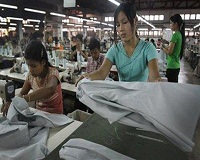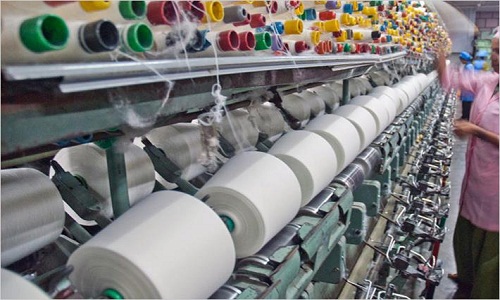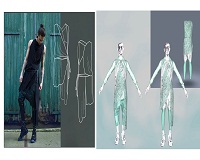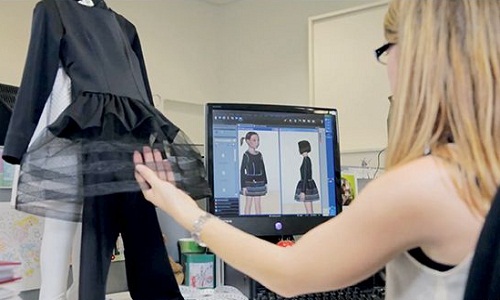FW
"Shifts in how we make and consume clothing are stretching planetary resources to breaking point, feels Michael Stanley-Jones, Nairobi-based Programme Management Officer of UN Environment’s Poverty-Environment Initiative. As per a 2016 McKinsey report, clothing production has doubled, the average consumers’ apparel purchase has increased by 60 per cent, and the average usage duration of apparel has halved between 2000 and 2014. Another report by the Ellen MacArthur Foundation found the lost value of wasted apparel due to underuse and lack of recycling reached $500 billion annually."
 A recent McKinsey study shows the number of urban fashion consumers will double to two billion by 2025. Behind this rosy picture lies a startling reality of being the world’s second largest industrial polluter after oil and employs over 60 million workers throughout the global value chain. But growing awareness among consumers and the need to achieve anti-poverty Sustainable Development Goals (SDGs) by 2030 requires a dramatic transformation.
A recent McKinsey study shows the number of urban fashion consumers will double to two billion by 2025. Behind this rosy picture lies a startling reality of being the world’s second largest industrial polluter after oil and employs over 60 million workers throughout the global value chain. But growing awareness among consumers and the need to achieve anti-poverty Sustainable Development Goals (SDGs) by 2030 requires a dramatic transformation.
Shifts in how we make and consume clothing are stretching planetary resources to breaking point, feels Michael Stanley-Jones, Nairobi-based Programme Management Officer of UN Environment’s Poverty-Environment Initiative. As per a 2016 McKinsey report, clothing production has doubled, the average consumers’ apparel purchase has increased by 60 per cent, and the average usage duration of apparel has halved between 2000 and 2014. Another report by the Ellen MacArthur Foundation found the lost value of wasted apparel due to underuse and lack of recycling reached $500 billion annually.
Sustainable fashion solutions could include slower consumption, more environmentally responsible production, recycling of used fabrics, and promoting ‘durable, reusable, and eco-friendly’ fashion. Stanley intends to instill a stronger understanding of the underlying principles of ‘circular’ or no-waste economy as it applies to fashion, leading to action at each stage of the supply chain, beginning with the more sustainable sourcing of materials for textile and fabric design, and ending with exploration of possible alternative markets to source and distribute and recover clothing, during his participation at the upcoming Global Landscapes Forum digital summit – Fashion for the Sustainable Development Goals: Sustainable Supply Chains and Green Job Opportunities for Youth and Women.
‘durable, reusable, and eco-friendly’ fashion. Stanley intends to instill a stronger understanding of the underlying principles of ‘circular’ or no-waste economy as it applies to fashion, leading to action at each stage of the supply chain, beginning with the more sustainable sourcing of materials for textile and fabric design, and ending with exploration of possible alternative markets to source and distribute and recover clothing, during his participation at the upcoming Global Landscapes Forum digital summit – Fashion for the Sustainable Development Goals: Sustainable Supply Chains and Green Job Opportunities for Youth and Women.
UN Interventions
A High Level Political Forum on Sustainable Development is scheduled at the UN headquarters in New York this July, which will focus on UN plans to launch a Partnership for Sustainable Fashion. As Stanley says, agreeing on its scope and engaging with stakeholders are high on this agenda, naming the private sector, investors, researchers, farmers, activists, innovators, designers, educators, youth and the media among targeted stakeholders. This partnership will be part of UN Environment’s Poverty-Environment Action for Sustainable Development Goals 2018-2022 (PEA SDG), scheduled for launch in late 2018 as a programme for bringing pro-poor, environmentally sustainable management of natural resources into the heart of government decision-making.
The UN Framework Convention on Climate Change anticipates a 60 per cent increase in fashion industry’s greenhouse gas emissions and waste by 2030 if transformation towards a sustainable fashion industry fails to materialise soon. Pressing environmental issues in the fashion industry include controlling its water and energy footprint, facilitating closed loop recycling, promoting sustainable materials, halting overproduction and treating waste appropriately.
Freshwater resources are stressed by cotton production and consumption during processing. Producing and consuming countries’ water bodies both suffer from wastewater pollution. Energy consumption is heightened by the production of synthetic fibers, which are petroleum-based. Synthetic micro-fiber pollution is of increasing concern with micro-plastics being washed in water bodies and showing up in aquatic species at alarming rates, he added.
Driving change
With a view to drive change, incentives such as green finance will be required for stimulating the fashion industry’s transition towards sustainability, Stanley-Jones said. One promising area is soil carbon sequestration, techniques for increasing soil fertility and increasing carbon capture by farms and grazing lands. Reforms may be introduced through assessment of landscapes’ potential to serve as carbon sinks, and the awarding of credits to those field managers who implement them, he explained.
The UN Food and Agriculture Organization’s Ex-Ante Carbon-balance Tool (EX-ACT) is a cost-effective land-based accounting system, which estimates the impact of agriculture and forestry on a landscape’s carbon balance, comparing policy change and business-as-usual scenarios. It can be applied to evaluate the fashion industry’s value chain. Moreover, the Sustainable Apparel Coalition is best known for developing the Higg Index, which aims to holistically measure members’ sustainability in terms of product design, facility labour conditions, and brand environmental-social impacts, encouraging members to be transparent in sharing and comparing scores for public scrutiny. Currently, there is not yet a clear roadmap determining the fashion industry’s global sustainability standards, and the upcoming establishment of the UN Partnership for Sustainable Fashion will help pave the way.
 Myanmar textile factories have been facing the heat of higher labour wages as union officials still don’t feel that the new minimum wage of K4,800 is enough to cover the increasingly high cost of living, especially in urban areas where most factories are located, and have demanded K5,600 to K6,600. In lieu to this, employers argue that the increase is justified given the other challenges they face, including high land prices, frequent power outages and low labour productivity. In the wake of the challenging scenario, people fear that the increase in wages will negatively impact the competitiveness of Myanmar’s garment sector globally. Only time will tell whether the 25 per cent increase has dulled the competitive edge of Myanmar’s garment industry.
Myanmar textile factories have been facing the heat of higher labour wages as union officials still don’t feel that the new minimum wage of K4,800 is enough to cover the increasingly high cost of living, especially in urban areas where most factories are located, and have demanded K5,600 to K6,600. In lieu to this, employers argue that the increase is justified given the other challenges they face, including high land prices, frequent power outages and low labour productivity. In the wake of the challenging scenario, people fear that the increase in wages will negatively impact the competitiveness of Myanmar’s garment sector globally. Only time will tell whether the 25 per cent increase has dulled the competitive edge of Myanmar’s garment industry.
Myanmar textile factories have been facing the heat of higher labour wages as union officials still don’t feel that the new minimum wage of K4,800 is enough to cover the increasingly high cost of living, especially in urban areas where most factories are located, and have demanded K5,600 to K6,600. In lieu to this, employers argue that the increase is justified given the other challenges they face, including high land prices, frequent power outages and low labour productivity. In the wake of the challenging scenario, people fear that the increase in wages will negatively impact the competitiveness of Myanmar’s garment sector globally. Only time will tell whether the 25 per cent increase has dulled the competitive edge of Myanmar’s garment industry.
enough to cover the increasingly high cost of living, especially in urban areas where most factories are located, and have demanded K5,600 to K6,600. In lieu to this, employers argue that the increase is justified given the other challenges they face, including high land prices, frequent power outages and low labour productivity. In the wake of the challenging scenario, people fear that the increase in wages will negatively impact the competitiveness of Myanmar’s garment sector globally. Only time will tell whether the 25 per cent increase has dulled the competitive edge of Myanmar’s garment industry.
The true picture
Myanmar has the second lowest minimum wage in the region, with only the garment manufacturing giant Bangladesh paying its labour force less. While wages are comparatively low in Myanmar, the low productivity of its workers is the main reason that CMP garment factories have only trickled to Myanmar. A 2017 study by the Centre for Economic and Social Development found that productivity here is considerably lower than elsewhere in the region. In Thailand, Malaysia, and Vietnam, the garment sectors are about six times more productive than in Myanmar, while Cambodia and Laos are two to three times more productive. This means that despite Myanmar’s relatively low wage companies are likely to find it more profitable to remain in these other countries. On the other hand, China’s minimum wage has risen to a point where it is now cost-effective to operate in Myanmar, and there has been a steady migration of factories from China to Yangon.
The cache is that the significant wage rise doesn’t necessarily guarantee any increase in productivity, which can result in Myanmar losing the competitive advantage in order to attract foreign investment in the garment industry. In that scenario, manufacturers may opt for moving to a neighbouring country with higher productivity, such as Thailand, or one with a lower wage. Bangladesh has increasing chance of luring companies due to its lower minimum wage and higher productivity.
Retaining competitiveness
Currently many garment factories in Myanmar use a system of bonuses to increase productivity and attendance, providing labour with a monetary incentive to meet production targets. While many of the larger factories are earning enough to accommodate the increase in minimum wage and maintain their bonus system, this scenario doesn’t work well for locally owned small and medium-sized factories that are mainly involved in sub-contracting or very low-end CMP work. They will probably be forced to decrease the labour incentives offered to workers for meeting production targets in order to maintain wage costs.
The country’s immediate focus should be on reducing the costs of doing business to a level comparable to Myanmar’s regional counterparts to incentivise foreign investment in Myanmar’s garment industry. Myanmar’s government has already started taking steps to reduce the costs of doing business through tax breaks and infrastructure improvements. The Ministry of Electricity and Energy recently announced plans to double Myanmar’s power generation capacity by 2022 to address one of the biggest headwinds for garment factory operations. Poor transport infrastructure is another major burden for factory owners and the Ministry of Transport and Communications is working with the Japan International Cooperation Agency to ease congestion and improve access to Yangon port.
Another option that has been successful in China and Vietnam, is a regional minimum wage that reflects the different cost of living in each state and region. In Yangon where the cost of living is very high, a minimum wage of K4,800 a day may not be enough for workers to support themselves without also undertaking a large amount of overtime. However, in a city such as Pathein, where the cost of living is lower, it might be feasible to have a lower minimum wage. A regional minimum wage could potentially attract garment factories to industrial zones in smaller cities once the necessary infrastructure is built.
"Although many fashion and apparel companies have adopted tools, such as Adobe Creative Suite and PDM systems within their product development process, the implementation of 3D virtual prototyping tools have been met with resistance. The reasons vary from company to company but they must be addressed as the immense number of physical samples that are produced and shipped across the globe during the product development process, necessitates new, sustainable practices based in innovative tools."
 Although many fashion and apparel companies have adopted tools, such as Adobe Creative Suite and PDM systems within their product development process, the implementation of 3D virtual prototyping tools have been met with resistance. The reasons vary from company to company but they must be addressed as the immense number of physical samples that are produced and shipped across the globe during the product development process, necessitates new, sustainable practices based in innovative tools.
Although many fashion and apparel companies have adopted tools, such as Adobe Creative Suite and PDM systems within their product development process, the implementation of 3D virtual prototyping tools have been met with resistance. The reasons vary from company to company but they must be addressed as the immense number of physical samples that are produced and shipped across the globe during the product development process, necessitates new, sustainable practices based in innovative tools.
3D virtual prototyping for apparel design and product development offers the opportunity for fashion and apparel companies to streamline their current process. Moreover, it provides a means of communication centered around a single, digital asset that can be used by all departments, vendors, and manufacturers. Even with these benefits, there are common points of resistance that exist in the fashion and apparel industry that hinder the adoption of 3D virtual prototyping:
3D not a gimmick
While 3D modeling is standard practice within creative departments in automotive, aerospace, architecture, and industrial design, 3D modeling is stereotyped as a tool specifically for computer-generated imagery. It is frequently associated with video games and animated films, inciting negative reactions when proposed as a tool for the fashion industry.
stereotyped as a tool specifically for computer-generated imagery. It is frequently associated with video games and animated films, inciting negative reactions when proposed as a tool for the fashion industry.
Yet, if we examine the evolution of 3D modeling, specifically 3D cloth simulation, garments in recent video games and animated films are intricate, drape dynamically, and animated characters wear multiple outfits made of different materials throughout an entire film. Even in films with human actors where 3D garments are used, it is difficult to tell when the garment is real or digital. 3D cloth simulation has come a long way over the past decade, and when paired with the right hardware, accurate virtual representations of designs can be achieved within a matter of minutes.
3D is not a gimmick. Even though 3D cloth simulation is used by other industries, when this technology incorporates features that can translate a virtual prototype into physical reality, designs can be clearly communicated, the number of physical samples per style can be greatly reduced, and more time can be spent on designing better, more creative products for your consumers.
Fear of change
Considering 3D virtual prototyping often elicits negative feelings from those involved in product development and design. It is a technology that challenges their current day-to-day process, and the change that comes with adopting this type of innovative technology can be extremely daunting.
This fear or resistance is rooted in a lack of trust in 3D technology — believing it cannot be applied to visualise a variety of garment categories, fabrics, or design details. In addition, new technology is generally applied towards the end of a product’s lifecycle. It is now common to experience retail environments where augmented reality and virtual try-on mirrors are being used. This ultimately overshadows the benefits of 3D technology and how it can innovate the entire process, beginning with the design phase.
Indeed 3D garment simulation has improved tremendously and is reliable in visualizing designs before a physical prototype is made. The technology has reached a tipping point where the virtual expression of various garment categories, design details, and fabrics is no longer limited. It can be used to create highly realistic images that can extend to marketing and e-commerce.
However, rolling out 3D virtual prototyping does not have to be an abrupt, sudden end-to-end change. Focusing on a few garment categories or styles can be a great way to prove that 3D works for your company. This can be achieved by working with a technology partner to complete a proof of concept, or with existing vendors and manufacturers to pilot a new 3D process around a small, but specific number of styles. The most important thing is to start in the early stages of apparel design and product development and grow the 3D ecosystem from there. Many manufacturers have already adopted 3D virtual prototyping tools as well, and they can play a key role in easing your company into a product development process that includes 3D.
No Time to learn new software
The fast-pace of the fashion calendar coupled with the demand for shorter lead times makes it difficult to set aside time to incorporate new technology. The work hours of those involved in product development process are spent chasing samples, attending multiple fit sessions for numerous styles, and constantly updating flat sketches and tech packs.
Although many have come to understand that 3D can drastically change the way they work, the current state of the product development process makes it difficult for them to dedicate even a fraction of their work hours to learning and applying 3D.
There are a few options available that have been put into practice by companies to address this issue. Certain companies have opted to establish teams that specifically create 3D garments, as well as investigate other technologies that will improve the overall product development process. Academic institutions are also a great resource for new talent, and many schools are beginning to incorporate 3D solutions into their design courses.
Another option would be to find the right people within the company who are open to 3D, reassign some of their tasks, and provide the time and space for them to develop their skills in 3D, within a manageable timeframe.
Resistance to implementing 3D virtual prototyping exists within the fashion and apparel industry, but many companies are adopting 3D and reaping benefits. They utilise 3D garments generated from 3D virtual prototyping tools to increase speed to market and obtain valuable consumer data analytics. Sample accuracy has increased with their network of vendors and interdepartmental communication has improved. Ultimately, 3D is a tool that serves to innovate how design is communicated across all stages of a product’s lifecycle — a clear visual representation of silhouette, drape, and design.
USA based fashion technology provider Tukatech recently appointed Chris Walia as its Chief Operating Officer (COO). Walia joined the company in 2017 as the head of its Global Operations.
Walia will continue to oversee implementation of Tukatech’s suite of software solutions such as TUKAcad, TUKA3D, and SMARTmark for product development and manufacturing products such as plotters, automatic cutters, laser cutters, and fabric spreaders.
Additionally, he will work on the overall strategy and operations of TUKAgroup, which consists of TUKATECH, TUKAweb, and TUKAcenters.
Prior to joining Tukatech, Walia held senior level positions for prominent apparel and IT solution companies. He has over fifteen years of experience in various aspects of the garment industry.
Founded in 1995 by Ram Sareen, Tukatech offers innovative tools for the apparel industry, maximising productivity from the pattern room to the cutting floor. The company’s solutions include TUKAcad (an award-winning pattern making design software), TUKA3D (a 3D virtual fit and design suite), TUKAcloud (an online collaboration platform), SMARTmark (a powerful marker-making program), and automatic computer-aided machinery for plotting, spreading, and cutting fabric.
Exporters of Tirupur are apprehensive that the 25 basis points hike in the repo rate will have a detrimental impact on knitwear exports from this region.
They feel the repo rate increase will further impact their business, particularly as they operate on wafer-thin margins.
Also interest rates are high when compared to rates prevailing in the international market. Orders are taken in advance and they are not in a position to revise the price. This will impact small and medium enterprises as there is stiff competition and they are already losing out to competing countries.
The Interest Equalisation Scheme had provided for three per cent interest subvention to compensate for the high rate. But this three per cent is seen as inadequate.
Exporters have appealed for a two percentage point increase in the Interest Equalisation Scheme (from three per cent to five per cent) with immediate effect to compensate the 25 basis point hike in repo rate.
They further want banks to take a lenient view while extending credit to small and medium enterprises.
Knitwear exporting units have been under pressure since the implementation of GST. Knitwear exports from Tirupur slipped to Rs 24,000 crores during the last fiscal against Rs 26,000 crores in 2017-18.
A number of textile dye and chemical companies have signed an open letter to the Stichting ZDHC Foundation discussing their concerns for the textiles value chain, which are proving an obstacle to the overall goals of the elimination of hazardous chemistry from within the textiles supply chain.
The companies – Archroma, Colourtex, DyStar, Huntsman, Jay Chemical, Protex, Pulcra, Rudolf, and Tanatex –expressed their concerns regarding additional financial burdens being placed on the industry by brands who seek to differentiate their offering on the basis of an additional modified “individualised” Manufacturing Restricted Substance List (MRSL).
The signatories also acknowledged that in order for the ZDHC to function efficiently, a mechanism must be in place to ensure that funds are available.
Stichting ZDHC Foundation was formed in 2014, to change the funding of the collaboration to a multi-stakeholder approach.
Previously the initiative’s internal activities had been primarily organised and funded by the ZDHC member brands.
The International Conference of the European Industrial Hemp Association (EIHA) will be held from June 12-13, 2018 in Cologne, Germany.
Around 350 participants from 40 countries are expected to participate in the event that will discuss the latest developments from all areas of the hemp industry – from seeds to the end product. Around 20 exhibitors will present their latest technologies and products in the event.
A major highlight of the conference will be an innovation award for the Hemp Product of the Year, presented for the first time ever. This award will honor three products – each from the areas of food, cosmetics and biocomposites. Participants will select the winners per category based on a short introduction of the products. The award winners will then be announced during the dinner ceremony.
The event will be organised by the German nova-Institut in close cooperation with the European Industrial Hemp Association. The day before the conference, EIHA will host expert workshops for members, meet representatives from Canada, USA and China.
‘Savers’ released its third annual State of Reuse Report, which reveals that while people consistently state they are donating or finding ways to extend the life of their items, 60 percent of North Americans shop secondhand only once a year or less.
Each year, the world consumes 80 billion new pieces of clothing, and 26 billion pounds of clothing and textiles go into landfills — 95 percent of which could be reused or recycled. Around 46 percent of them felt they had way too much stuff and 53 percent were driven to give items away because they had accumulated too much clutter.
‘Savers’ found that saving money is the primary reason for 57 percent people who shop second hand. Around 69 per cent of them felt that buying pre-owned goods was like finding hidden treasure and 77 percent have been surprised by the great pre-owned items they’ve found.
Bulgaria, Romania and other countries in the Balkan region have established a foothold in the luxury market and fashion houses from Paris and Milan are quietly building a bigger presence as they feed demand for a quicker turnover of styles.
More affordable labels have long produced bags, scarves, clothes and shoes in southeastern Europe, but margins are becoming slimmer as Balkan companies jostle for that business with China, Turkey and, increasingly, Africa.
The luxury sector is expected to grow up to five per cent this year, outpacing fashion as a whole, encouraging southeastern Europe to focus its efforts on attracting more upmarket clients alongside competitors such as Portugal.
Factories near the Danube are positioning themselves to help top brands adjust to faster fashion cycles.
Orders and enquiries from top brands are increasing and they have invested in machines to do the specialised stitches, buttons and ironing they demand alongside hand sewing, which is sometimes done through contractors.
For the brands, the cost advantage of nearby countries with the lowest wages in the European Union is not the only factor in an era where word of lapses in quality or poor working conditions spreads fast.
While top French and Italian luxury houses have experimented with manufacturing outside their home base for years now, it is often for more basic garments such as branded T-shirts.
But the need for small batches of work, done fast, to exacting standards, is growing.
According to a research report, the opportunity in the global luxury apparels market will be worth US$60,793.7 million by the end of 2024 from US$1,8842.69 mn in 2015.
Between the years of 2016 and 2024, the global market is expected to expand at a CAGR of 13.2%. The increasing affordability of luxury apparels is attributable to the mass production of goods, which has transformed the 19th-century ways of dress making.
The luxury apparels market boasts of an esteemed clientele comprising the high net worth individuals.
However, over the years several designers and fashion brands have started reaching out the broader range of customers through affordable products.
Big brands such as Louis Vuitton, Prada, and Versace are expanding to developing economies, which has not only improved their geographical reach but also won them a newer consumer base.












